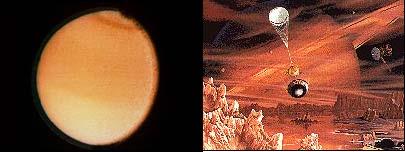Titan, Saturn's largest moon, may have lakes or even oily oceans on its surface, according to a recent radar study

In the left picture: what is hiding under the clouds? Right: Will the Huygens spacecraft wade through liquids?
Titan. At a temperature of minus 178 degrees Celsius the liquid cannot be water
Titan may have oily oceansAvi Blizovsky, 9/10/03
Titan, Saturn's largest moon, may have lakes or even oily oceans on its surface, according to a recent radar study
The Giant Radio Telescope in Arecibo, Puerto Rico sent a beam of radio waves at Titan and detected a faint echo two hours later. Analysis of the dim signal suggests the presence of craters filled with oily oceans or at least such lakes below the clouds.
In January 2004, the European spacecraft Huygens will descend on the surface of Titan and try to find out what is there.
Titan is one of the enigmatic moons and one of the most significant bodies in the solar system.
Optical observations cannot penetrate the photochemical smog that surrounds the world, but infrared light and radar can penetrate, revealing the diverse surface beneath the clouds.
Observations from ground-based telescopes and the Hubble Space Telescope have already produced rough maps of the surface, showing what may be a continent of rock and ice surrounded by days or lakes made of hydrocarbons.
Hydrocarbons - mainly methane and ethane can create oily oceans on the surface and have coastlines of glaciers reinforced by hydrocarbons falling from the sky.
Arecibo's signals took 15 hours and XNUMX minutes to reach Titan and back. Only a tiny bit of the energy that was also transmitted back and received in Arecibo and the radio telescope in Green Bank in the USA.
As expected, the echo was very diffuse. In most cases a sharp signal was received as expected from smooth surfaces such as the surface of oceans.
The confirmation for this may come during the coming year when the Cassini spacecraft will reach Saturn and begin a series of approach flights to Titan. In January 2005, Cassini will drop the Huygens spacecraft on Titan, which may be wading through such an ocean when it lands.
The study was published in the scientific journal Science.
For news at the BBC
Titan's hydrocarbon lakes
By Kenneth Chang New York Times
First evidence of the existence of liquid reservoirs on the large moon of Saturn
The face of Titan, the largest moon of the planet Saturn, has something very flat, maybe even as flat as the surface of an ocean. Using an interstellar-scale radar experiment, astronomers have made the first observations that contribute to the confirmation of an old suspicion, according to which liquid oceans cover a large part of Titan.
Since the temperature on Titan is estimated to be minus 178 degrees Celsius, the liquid cannot be water. Scientists suspect that these are hydrocarbons, molecules consisting only of hydrogen and carbon. Methane gas is the lightest hydrocarbon; Heavier hydrocarbons are the main components of smog.
Researchers from Cornell University, the University of Virginia and NASA's Jet Propulsion Laboratory reported their findings in an article published earlier this month on the website of the journal Science. Titan fascinates the scientists studying the planets. This moon is larger than the planets Mercury and Pluto (5,150 km in diameter), and its atmosphere, which is mainly composed of nitrogen, is thicker than Earth's.
Some astronomers suspect that conditions on Titan may be similar to those that existed on the young Earth. Although few expect to discover life on the moon, "it is possible that this is a natural laboratory for the study of the chemical processes leading to the appearance of life", said Dr. Jonathan Lunin, from the Lunar and Planetary Research Laboratory at the University of Arizona.
A few decades ago, author and cosmologist Carl Sagan hypothesized that the methane in Titan's atmosphere could solidify and form an ocean over the entire surface of the moon. When NASA's two Voyager spacecraft flew past Saturn in November 1980 and August 1981, their cameras were unable to penetrate the orange haze of Titan's atmosphere to observe the surface. But their instruments did not measure methane in the amount expected to evaporate from an ocean of pure methane.
In 1994, the Hubble Space Telescope photographed Titan in the field of infrared light, which penetrates through the clouds of the atmosphere. The photographs showed dark areas next to light areas, which rules out the possibility that an ocean covers the entire surface of the moon. The bright areas are probably ice, but the dark areas may be hiding days of hydrocarbons.
In November 2001, when Titan entered the "view" range of the Arecibo radio telescope in Puerto Rico, the telescope, which was operated for the purpose of the research like a giant radar, fired the first series of radio signals towards the moon. After traveling 1.2 billion kilometers and reaching Titan, the signals were returned to the radar in Arecibo. The round trip took two hours and 15 minutes. A radio telescope in West Virginia was also used to detect the faint signals that returned.
Arecibo fired 25 signals at Titan. From the analysis of the special structure of most of the signals, the researchers concluded that the radio waves were returned from pools of liquid hydrocarbons. "This is evidence that there may be such pools there," said Dr. Campbell. "This is not unequivocal proof."
According to scientists, the size of the pools cannot be deduced from the findings and it is impossible to know whether they are large puddles, lakes or seas. Campbell said the signals may have been bounced off smooth solid surfaces, but he doubts much of Titan could be so smooth.
